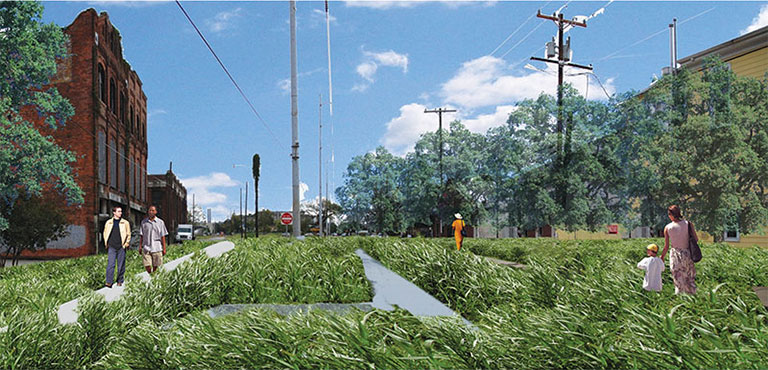Photo Essay
In Flood-Prone New Orleans, an
Architect Makes Water His Ally

Dutch Dialogues II
Water storage is fundamental in New Orleans. This vision of Felicity Street uses vegetation and stormwater catchment basins to mitigate runoff.
View the photo essay.
View the photo essay.
No city in the United States faces as grave a threat from flooding, hurricanes, and rising seas as New Orleans, part of which lies below sea level. But New Orleans architect David Waggonner and his associates, learning lessons from the Dutch, have proposed a revolutionary vision for New Orleans that seeks to make an asset of the water that surrounds the city, remaking unsightly canals into an important and scenic part of the landscape and mimicking nature to store rainfall. Waggoner’s firm has been chosen to help develop a Greater New Orleans Urban Water Plan, a first step in what could be a multi-billion dollar project to redesign the ways in which the region co-exists with water. “To sustain the city in this difficult site in an era of rising seas and more extreme weather, we must convert our necessities into niceties, into desirable places that connect with people and culture,” Waggonner told Yale Environment 360.
10 Feb 2014
View the photo essay.
CONNECT WITH YALE e360
Subscribe to NewsletterFollow us on Twitter
Like us on Facebook
MORE FROM E360
To Control Floods, The Dutch
Turn to Nature for InspirationThe Netherlands’ system of dikes and sea gates has long been the best in the world. But as the country confronts the challenges of climate change, it is increasingly relying on techniques that mimic natural systems and harness nature’s power to hold back the sea.
READ MORE
Too Big to Flood? Megacities
Face Future of Major Storm Risk
As economic activity and populations continue to expand in coastal urban areas, particularly in Asia, hundreds of trillions of dollars of infrastructure, industrial and office buildings, and homes are increasingly at risk from intensifying storms and rising sea levels.
READ MORE
To Tackle Runoff, Cities
Turn to Green Initiatives
Urban stormwater runoff is a serious problem, overloading sewage treatment plants and polluting waterways. Now, various U.S. cities are creating innovative green infrastructure — such as rain gardens and roadside plantings — that mimics the way nature collects and cleanses water.
READ MORE